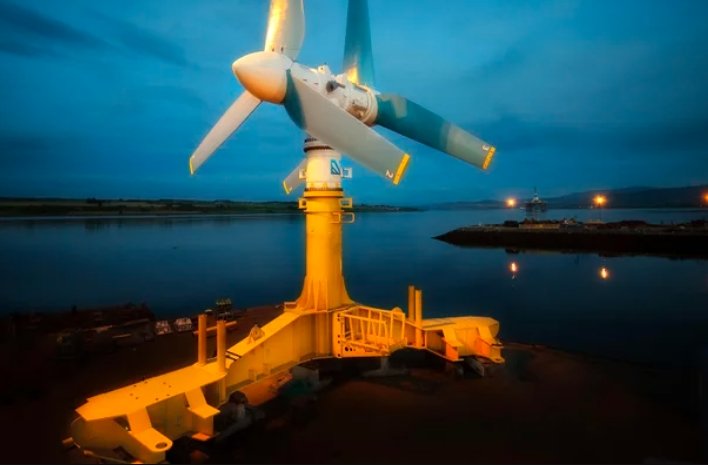They call it a renewable milestone. Four underwater turbines off the Caithness coast, churning out clean power as tides roll in and out. But a closer look at Scotland’s MeyGen project suggests that while the tides may be free, the electricity certainly isn’t.
The Numbers Beneath the Waves
It sounds poetic — turbines spinning silently beneath the surf, catching the moon’s pull. Yet the money side of it is a bit less dreamy. MeyGen’s first phase, four turbines producing six megawatts, cost around £51 million back in the mid-2010s. Factor in inflation and we’re talking £66 million today — about US$90 million.
So far, these underwater giants have generated around 51 million kilowatt-hours (kWh). For context, that’s enough to power maybe 15,000 average UK homes for a year. Not bad — until you do the math.
One simple sum: $90 million divided by 51 million kWh equals roughly $1.78 per kWh.
Meanwhile, the US grid average for natural gas power? Just about 4–6 cents per kWh. So you’re looking at a tidal power price more than thirty times that. Yikes.

Will It Get Cheaper?
Supporters argue this is early-stage stuff — costs will drop as the technology matures, right? Maybe. But the ocean is no easy partner. Salt water eats metal. Currents shift. And underwater maintenance is as pricey as it sounds.
Industry watchers reckon MeyGen’s four turbines will run for 25 years. By then they might generate 164 million kWh in total. But there’s more spending ahead. The turbines need at least two major overhauls — about $3 million a pop — plus ongoing maintenance. Add it all up and you land near $102 million for the project’s full lifespan.
• Lifetime power cost works out to around $0.62 per kWh
• That’s still 10 times the cost of gas-fired generation
And that’s the best-case scenario. If a gearbox cracks or a blade corrodes early, repairs can mean divers, boats, specialist gear — all at ocean prices.
That Pesky Capacity Factor
One big reason tidal projects like MeyGen struggle to compete? The so-called “capacity factor.” It measures how much power a system actually produces compared to its theoretical maximum.
Here’s the rub: MeyGen’s turbines each have a 1.5 MW nameplate capacity. Add up their working years so far and they’ve delivered about 51 GWh instead of 407 GWh. That means a capacity factor around 13% — painfully low for such costly kit.
For comparison, wind turbines can reach 30–50% and gas plants often hit 85% or higher.
So, why so low? Tides are predictable but not constant. And when those turbines do spin, they don’t always run flat out. Add harsh weather and corrosion and you’ve got an expensive trickle instead of a roaring current.
Is It Just Growing Pains?
Some say we shouldn’t knock it. After all, tidal tech is still young. Every new energy source starts off expensive. Remember early offshore wind? The costs were eye-watering back then too.
The Scottish government remains keen, banking on its rugged coastline to lead the way in renewables. And there’s genuine value in reliable baseload generation that doesn’t depend on sunshine or steady winds.
But for that to work, capacity factors need to improve. Maintenance needs to get cheaper. And private investors need to see a path to profits without constant government support.
The next phases of MeyGen are meant to be bigger and more efficient. But each new turbine adds millions more to the risk pile. Will they hit breakeven before corrosion claims the hardware? Time will tell.
So, What’s the Net Gain?
It’s not all doom and gloom. The turbines have put real renewable power on the grid. Jobs have been created in engineering, marine logistics, and coastal communities that otherwise face economic headwinds.
Yet, that doesn’t make the math any prettier. Even with a generous green lens, $0.62 per kWh is a long way from affordable.
Take a glance at this comparison:
| Generation Type | Average Cost per kWh (US$) |
|---|---|
| Natural Gas | $0.04–$0.06 |
| Onshore Wind | $0.02–$0.05 |
| Solar Utility | $0.03–$0.05 |
| Tidal (MeyGen) | $0.62 |
Those numbers make investors squirm. And taxpayers foot much of the difference through subsidies and incentives.
Still, there’s hope the experience gained will push the next wave of designs forward. If the Scots crack the maintenance puzzle and boost output, they could yet prove that tidal energy can stand on its own — and not just float on government cash.


















